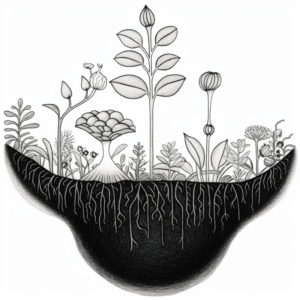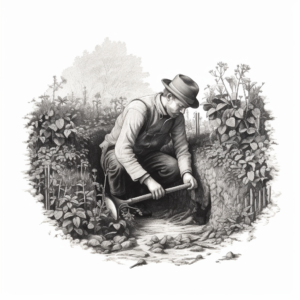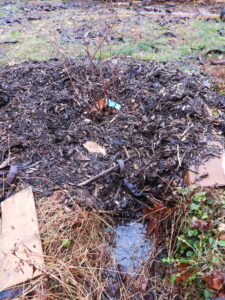On our first homestead, ground water was so high in certain areas that we had to build extra-tall mounds just to prevent plant roots from drowning. On our current ridge, the problem is the exact opposite and I hope the solution is the opposite too.
 What’s a pit garden?
What’s a pit garden?
A pit garden is simply a garden bed located below the natural level of the surrounding earth. The idea is to concentrate and hold onto moisture, both groundwater and runoff from the surrounding terrain.
Alternatively, if you locate your pit garden where it gets runoff from your roof, you’ve created a rain garden. Whether a rain garden will rot roots depends on your climate and what you plant. But if you’re on a dry ridgetop like we are, it might be just the ticket!
How to know if you need a pit garden
Does your ground dry up and crack at least once a year? Do you irrigate and still lose shallow-rooted perennials like blueberries? Do volunteer vegetables come up in your mulched aisles more than in the good soil of your raised beds? Do broadcast-seeded plants germinate fitfully in the middle of your beds but better around the (lower-down) edges?
If any or all of these field marks sound familiar — try a pit garden (or rain garden, or both)!
 How to build a pit garden
How to build a pit garden
Dig a trench then backfill it most of the way with excellent soil (putting the old subsoil somewhere else). Your goal is to have any mulch hit right at the natural elevation of the surrounding earth.
Next, plant and enjoy the result!
(By the way, the diagrams in this post are courtesy of Midjourney…who doesn’t seem to understand what either a shovel or a spade is. My correction: dig your trench with a spade, not whatever that gardener has in his hand…)
 What we did
What we did
In our case, we’d dug the beginnings of a foundation for a wood-stove-room addition. Then (as usually happens with me), I lost interest in putting time and energy into house when I could put the same time and energy into outdoors and plants.
So I moved acidified soil from our blueberry patch into our premade pit garden. Next, I transplanted a cranberry and a few blueberries that had barely been hanging on in the main garden into that good, low earth.
Our spot is definitely a rain garden in addition to a pit garden, and in some very wet years the trench used to hold enough water for tadpoles to mature. (You can see what it looks like after a sixth of an inch of rain in the photo.) I’ll report back and let you know if that’s too much water or just right for our ericaceous crops.
 Winter break
Winter break
In other news, we’re taking a bit of a winter break while Mark heals up a back injury and I stick to the basics to keep the homestead running and myself sane. I’ll tell you about our edible-seed-sprouting experiments and more when life smooths out again.
If you miss hearing from us while you wait, why not check out our gardening video courses or deep-dive into gardening topics with our books?